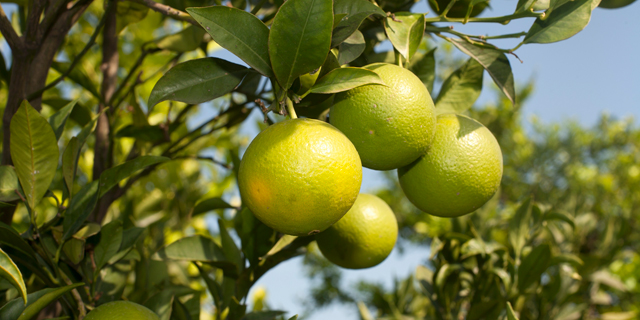“We’ve
been hit really hard by the lime shortage. Our Latin menu centers on citrus
flavors, and we are paying through the nose for limes.” That’s Jill Cook,
marketing director for Matador Cantina, one of several restaurants in Orange
County, California, that are owned by Mario Marovic. Cook, as well as her
boss and many other restaurants owners, supermarkets, airlines and taco carts across
the country, is worried about the scarcity of the lime crop coming out of
Mexico.
A rare combination of circumstances – a perfect storm if
you will – has occurred this year that has driven prices of limes to record
highs for an ever-diminishing supply. In top producing Mexican states (Michoacan,
Colima, Guerrero and Veracruz) flooding, drought, and a disease called ‘citrus
green’ is crippling production. As a
result, less limes are making it north of the border. Mexican drug cartels are also
doing their part to keep prices high by stealing truckloads and either ransoming
the contents or selling them for premium prices. According to the USDA, lime
prices are soaring to as much as $120 a case (up from just $20 a case last year
at this time). The price of an individual lime in supermarkets will now set
consumers back $1, up from just $.29 last year.
Grocery stores
like Albertson’s and Melissa’s Produce, as well as restaurants such as Matador
Cantina are feeling the squeeze, and are being forced to pass those costs on to
their customers. Rather than having to
absorb the high cost of limes, many restaurants are substituting lemons in
place of limes. Airlines such as United, as well as fast food chains and taco
carts have followed suit. Today, when you order Carnitas el Momo from an LA taco
truck, your taco will be garnished with
wedges of lemon instead of the more traditional lime. Customers have even gone
so far as to rob vendors of whole containers of complimentary lime wedges from
condiment bars. It’s no wonder that in Mexico, limes have been given the
nickname oro verde or green gold.
Why is this shortage hitting so hard? Mexico supplies
over 90% of the limes eaten in the United States, and US lime production is just a drop in the bucket. “We have a lot of citrus production in the US but
limes are a little different,” said Peter Olson from the USDA’s office in Mexico City. “There are only a few
places in the US that have the ideal climatic conditions for lime production. They
need a different type of season.”
Next, how the lime shortage is affect your happy hour… [pagebreak]
Limes
are one of the most cold-intolerant members of the citrus family. California, Florida and Hawaii are the only US
states with conditions suitable for growing limes. However,
California’s citrus production is mainly dedicated to lemons. The state grows
41,000 acres of lemons, compared to just 400 acres of limes. According to an article about US lime
production recently published in Time magazine, California is a difficult place
for limes to thrive, as cool winds off the coast and cold nights can take out
whole crops.
Florida,
however, grew nothing but limes. In 2000, just after the lime crop had
recovered from devastating Hurricane Andrew, the disease known as citrus
canker threatened to take out not only limes, but also Florida’s citrus
darlings, the orange and grapefruit. Local officials ordered that land be
cleared within 1900 feet of an infected tree, thereby wiping out the lime crop.
Hawaii is simply too far away to compete
with Mexico’s normally cheap prices.
There
is hope. Mexico is coming out of winter, a dry spell for most of the citrus grown in the country, and the USDA thinks
prices will go back to normal soon. Peter Olson said, “No one can predict the
future but certainly, if you look at supply and demand, limes prices here in
Mexico and prices in the United States will moderate soon.”
Unfortunately,
the reprieve did not come soon enough for Cinco de Mayo festivities. This year,
revelers shelled out a few more bucks for their salt-rimmed margaritas,
mojitos, micheladas or any other lime-spiked libations.
However,
necessity is the mother of invention. Matador Cantina owner Mario Marovic, when
brainstorming ways to keep margarita prices affordable, came up with a genius bartering system. “He said to us,
‘Why not just offer a deal to incentivize our customers to bring us limes from
their home trees?’ That’s how we started offering $.25 margaritas in exchange
for limes,” said Jill Cook. The house margarita at Matador sets customers back
$10 each, so it’s no shock the restaurant has had interested patrons. “We’ve
had a handful of people [bring us limes], but also, because of the shortage,
our customers are more aware of where their food comes from, and that’s always
a good thing.”


![Making Mealtime Matter with La Familia: Easy Sofrito [Video]](https://thelatinkitchen.com/wp-content/uploads/2015/10/sofrito-shutterstock__0-500x383.jpg)
![Easy Latin Smoothies: Goji Berry Smoothie [Video]](https://thelatinkitchen.com/wp-content/uploads/2015/12/goji_berry-shutterstock_-500x383.jpg)
















![Fun and Fast Recipes: Fiesta Cabbage Salad [Video]](https://thelatinkitchen.com/wp-content/uploads/2015/11/fiesta_cabbage_slaw-shutterstock_-500x383.jpg)









